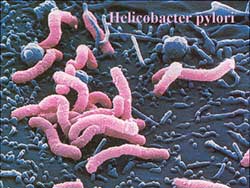Children also have chronic stomach ulcers
Stomach ulcer - Chronic duodenum in children is often caused by H.pylori bacteria. Children are more likely to experience complications such as gastrointestinal bleeding, ulcer perforation .

H.pylori bacteria (photo: fmed)
The most common disease is aged 7-13. H-pylori bacteria can be transmitted by mouth-to-mouth (often in children who live in families with peptic ulcer), feces - mouth (due to poor eating and hygiene, environmental pollution , contaminated water sources.
The symptoms
Abdominal pain is the most common symptom; most of them are prolonged and recurrent lumbar pain in the abdomen. Sometimes there is a lot of pain in the epigastric region or lower right flank (abdominal area on the navel on the right side of the patient). Pain is usually cyclical, related to meals.
Gastrointestinal hemorrhage: Can manifest very clearly such as vomiting of blood, bowel movements of black stools such as coffee grounds or fresh blood; It can also be very discreet that children and family members have difficulty recognizing.
Anemia: It is a common sign in most sick children with signs such as blue skin, pale mucosa, paleness of the white feet, fatigue, poor appetite, thinness and poor development.
Gastrointestinal disorders: Common signs are nausea and vomiting, especially in young children. Injury related to meals and pain. Vomiting may be food, sometimes blood.
Children often have a burning sensation in the epigastric region, with pain, accompanied by dyspepsia. Some children also show signs of belching, marked heartburn.
The dangerous nature of peptic ulcer disease in children is easy to cause deep ulcers leading to severe injury in this organ, gastrointestinal bleeding. In the long term, chronic disease progresses, affecting development. The disease is also associated with stomach cancer at an older age.
To confirm the diagnosis of duodenal ulcers, to examine and test specialty (endoscopy to determine the location and extent of injury, biopsy combination to find H-pylori and Urea Test to determine the presence H-pylori face).
- 6 important things about stomach ulcers everyone needs to know
- New pathogen from peptic ulcer disease
- Stress - The culprit in stomach disease
- People have had stomach ulcers since prehistoric times
- Children also have stomach ulcers
- Recognize stomach ulcers
- Horse milk is great for treating chronic ulcers
- People with stomach ulcers should eat sweet
- Peppers prevent and treat stomach ulcers
- Helicobacter pylori bacteria may be the culprit causing Parkinson's disease
- Skin spray treatment of foot ulcers
- O-type people are most likely to develop stomach ulcers
 Green tea cleans teeth better than mouthwash?
Green tea cleans teeth better than mouthwash? Death kiss: This is why you should not let anyone kiss your baby's lips
Death kiss: This is why you should not let anyone kiss your baby's lips What is salmonellosis?
What is salmonellosis? Caution should be exercised when using aloe vera through eating and drinking
Caution should be exercised when using aloe vera through eating and drinking